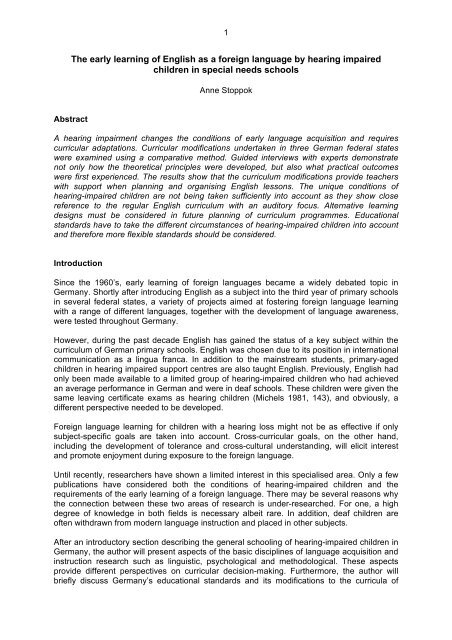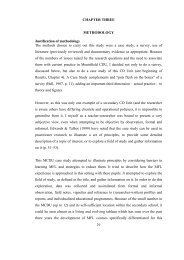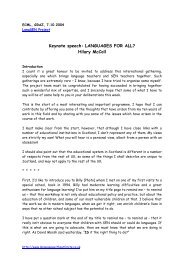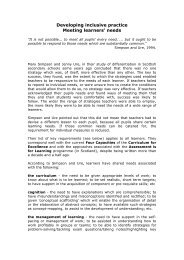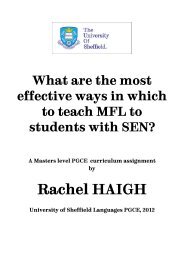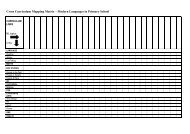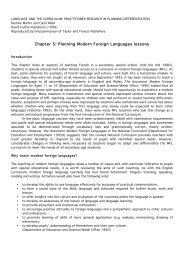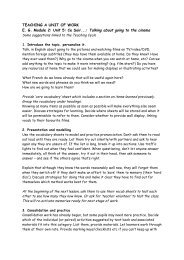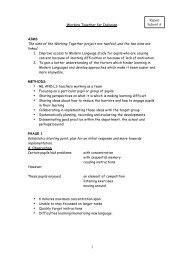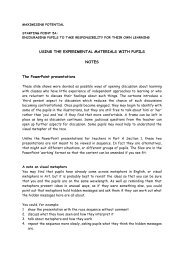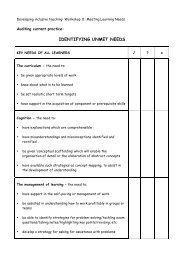The early learning of English as a foreign language by hearing ...
The early learning of English as a foreign language by hearing ...
The early learning of English as a foreign language by hearing ...
Create successful ePaper yourself
Turn your PDF publications into a flip-book with our unique Google optimized e-Paper software.
1<strong>The</strong> <strong>early</strong> <strong>learning</strong> <strong>of</strong> <strong>English</strong> <strong>as</strong> a <strong>foreign</strong> <strong>language</strong> <strong>by</strong> <strong>hearing</strong> impairedchildren in special needs schoolsAnne StoppokAbstractA <strong>hearing</strong> impairment changes the conditions <strong>of</strong> <strong>early</strong> <strong>language</strong> acquisition and requirescurricular adaptations. Curricular modifications undertaken in three German federal stateswere examined using a comparative method. Guided interviews with experts demonstratenot only how the theoretical principles were developed, but also what practical outcomeswere first experienced. <strong>The</strong> results show that the curriculum modifications provide teacherswith support when planning and organising <strong>English</strong> lessons. <strong>The</strong> unique conditions <strong>of</strong><strong>hearing</strong>-impaired children are not being taken sufficiently into account <strong>as</strong> they show closereference to the regular <strong>English</strong> curriculum with an auditory focus. Alternative <strong>learning</strong>designs must be considered in future planning <strong>of</strong> curriculum programmes. Educationalstandards have to take the different circumstances <strong>of</strong> <strong>hearing</strong>-impaired children into accountand therefore more flexible standards should be considered.IntroductionSince the 1960’s, <strong>early</strong> <strong>learning</strong> <strong>of</strong> <strong>foreign</strong> <strong>language</strong>s became a widely debated topic inGermany. Shortly after introducing <strong>English</strong> <strong>as</strong> a subject into the third year <strong>of</strong> primary schoolsin several federal states, a variety <strong>of</strong> projects aimed at fostering <strong>foreign</strong> <strong>language</strong> <strong>learning</strong>with a range <strong>of</strong> different <strong>language</strong>s, together with the development <strong>of</strong> <strong>language</strong> awareness,were tested throughout Germany.However, during the p<strong>as</strong>t decade <strong>English</strong> h<strong>as</strong> gained the status <strong>of</strong> a key subject within thecurriculum <strong>of</strong> German primary schools. <strong>English</strong> w<strong>as</strong> chosen due to its position in internationalcommunication <strong>as</strong> a lingua franca. In addition to the mainstream students, primary-agedchildren in <strong>hearing</strong> impaired support centres are also taught <strong>English</strong>. Previously, <strong>English</strong> hadonly been made available to a limited group <strong>of</strong> <strong>hearing</strong>-impaired children who had achievedan average performance in German and were in deaf schools. <strong>The</strong>se children were given thesame leaving certificate exams <strong>as</strong> <strong>hearing</strong> children (Michels 1981, 143), and obviously, adifferent perspective needed to be developed.Foreign <strong>language</strong> <strong>learning</strong> for children with a <strong>hearing</strong> loss might not be <strong>as</strong> effective if onlysubject-specific goals are taken into account. Cross-curricular goals, on the other hand,including the development <strong>of</strong> tolerance and cross-cultural understanding, will elicit interestand promote enjoyment during exposure to the <strong>foreign</strong> <strong>language</strong>.Until recently, researchers have shown a limited interest in this specialised area. Only a fewpublications have considered both the conditions <strong>of</strong> <strong>hearing</strong>-impaired children and therequirements <strong>of</strong> the <strong>early</strong> <strong>learning</strong> <strong>of</strong> a <strong>foreign</strong> <strong>language</strong>. <strong>The</strong>re may be several re<strong>as</strong>ons whythe connection between these two are<strong>as</strong> <strong>of</strong> research is under-researched. For one, a highdegree <strong>of</strong> knowledge in both fields is necessary albeit rare. In addition, deaf children are<strong>of</strong>ten withdrawn from modern <strong>language</strong> instruction and placed in other subjects.After an introductory section describing the general schooling <strong>of</strong> <strong>hearing</strong>-impaired children inGermany, the author will present <strong>as</strong>pects <strong>of</strong> the b<strong>as</strong>ic disciplines <strong>of</strong> <strong>language</strong> acquisition andinstruction research such <strong>as</strong> linguistic, psychological and methodological. <strong>The</strong>se <strong>as</strong>pectsprovide different perspectives on curricular decision-making. Furthermore, the author willbriefly discuss Germany’s educational standards and its modifications to the curricula <strong>of</strong>
2<strong>hearing</strong>-impaired children before presenting examples <strong>of</strong> three federal states’ attempts atmodifying the aforementioned curricula.Schooling <strong>of</strong> <strong>hearing</strong>-impaired children in GermanyAt present, the schooling <strong>of</strong> <strong>hearing</strong>-impaired children across different German federal statesis organised in four types <strong>of</strong> environments. As shown in Table 1, about 77% <strong>of</strong> children with a<strong>hearing</strong> impairment were taught at <strong>hearing</strong> impaired support centres in 2007/2008.Additionally, Germany practises three kinds <strong>of</strong> joint school placement: “integrational” cl<strong>as</strong>ses,“preventive” integration or open cl<strong>as</strong>ses and “external” cl<strong>as</strong>ses. Within integrational cl<strong>as</strong>ses,individual students are part <strong>of</strong> a regular school cl<strong>as</strong>s. A teacher from the regular schooldelivers the lessons, while a special needs teacher provides the support. However, theextent <strong>of</strong> the support varies among the federal states and is b<strong>as</strong>ed on the student’s academicyear. <strong>The</strong> preventive integration or open cl<strong>as</strong>ses target <strong>hearing</strong> <strong>as</strong> well <strong>as</strong> <strong>hearing</strong>-impairedchildren who are taught in one group at a <strong>hearing</strong> impaired support centre. In this situation,the special needs teacher is in charge <strong>of</strong> the cl<strong>as</strong>s. <strong>The</strong> third option is an external cl<strong>as</strong>s,which is a cl<strong>as</strong>s from a <strong>hearing</strong> impaired support centre located within an ordinary school’spremises. In this cl<strong>as</strong>s, <strong>hearing</strong> and <strong>hearing</strong>-impaired children are taught either <strong>by</strong> a specialneeds teacher or partly <strong>by</strong> a team consisting <strong>of</strong> regular and special needs teacher. (Hänel-Faulhaber 2008, 126)Pupils joining either the preventive integration or the external cl<strong>as</strong>ses show a comparablysimilar degree <strong>of</strong> psychologically felt integration. Hänel-Faulhaber define psychologically feltintegration <strong>as</strong> successful inclusion. (Hänel-Faulhaber 2008, 126 f.) <strong>The</strong> pupils feel included insocial networks <strong>as</strong> well <strong>as</strong> in cooperative actions. Hänel-Faulhaber concludes that this resultis possibly due to both group identification and a consideration <strong>of</strong> inidividual communicationneeds. Hänel-Faulhaber maintains that there remains a necessity to provide motivation forthe pupils to achieve.<strong>The</strong> sixteen German federal states have only recently started keeping statistics on the types<strong>of</strong> environments. <strong>The</strong> author h<strong>as</strong> chosen comparison statistics <strong>of</strong> the three largest <strong>of</strong> theGerman federal states; North-Rhine-Westfalia (“NRW”), Bavaria (“B”), and Baden-Württemberg (“BW”). <strong>The</strong>se three federal states represent approximately 50% <strong>of</strong> the entireGerman population <strong>of</strong> 82 million people. A statistical review shows a slight incre<strong>as</strong>e inintegrative <strong>learning</strong> <strong>by</strong> <strong>hearing</strong>-impaired children between the year <strong>of</strong> the first statisticalcoverage <strong>of</strong> integrated schooling in 1999 and the l<strong>as</strong>t school year <strong>of</strong> 2007/2008 (“2008”), witha general incre<strong>as</strong>e in the total number at the same time. While in 1999 there w<strong>as</strong> a totalnumber <strong>of</strong> 12,620 children with a <strong>hearing</strong> impairment, 9,997 were taught in support centerswith 2,623 children in a form <strong>of</strong> integration in general schools. In 2008 there were 14,382children with a <strong>hearing</strong> impairment at schools in Germany, 11,131 were taught in a specialsupport school, with 3,251 taught in a form <strong>of</strong> integration in general schools. (Sekretariat derStändigen Konferenz der Kultusminister der Länder in der Bundesrepublik Deutschland(KMK) 2003; KMK 2009)A comparison <strong>of</strong> the statistical tables about <strong>hearing</strong>-impaired students and their schooling inspecial and in mainstream schools in three individual federal states <strong>of</strong> Germany (see Table1) <strong>of</strong>fers a detailed view <strong>of</strong> the differences in special needs education within Germany.Differences can also be observed in the different kinds <strong>of</strong> mainstream schools which <strong>of</strong>ferintegrational cl<strong>as</strong>ses, with primary schools showing a slight incre<strong>as</strong>e in joint schoolplacements from 1,529 students in 1999 to 1,722 students in 2008. Comprehensive schoolsshow an initial figure <strong>of</strong> 129 in 1999 which rises to 196 in 2008. <strong>The</strong> figures indicate thatoptions for <strong>hearing</strong>-impaired children taught at a mainstream school decre<strong>as</strong>e <strong>as</strong> theacademic years incre<strong>as</strong>e. (KMK 2003; KMK 2009)
3Table 1: Number <strong>of</strong> students in types <strong>of</strong> <strong>learning</strong> environments1999 2001 2006 2007/2008SupportIntegrationalSupportIntegrationalSupportIntegrationalSupportIntegrationalCentercl<strong>as</strong>sesCentercl<strong>as</strong>sesCentercl<strong>as</strong>sesCentercl<strong>as</strong>sesGermany 9,997 2,623 10,475 3,054 11,167 3,269 11,131 3,251Total 12,620 13,529 14,436 14,382BW 1,540 319 1,629 458 1,830 887 1,864 828Total 1,859 2,087 2,717 2,692B 1,421 712 1,687 777 1,789 144 1,819 264Total 2,133 2,464 1,933 2,083NRW 2,395 221 2,480 243 2,788 379 2,802 390Total 2,616 2,723 3,167 3192Sources:Statistic 2003: http://www.kmk.org/fileadmin/pdf/PresseUndAktuelles/Dok170.pdfStatistic 2006: http://www.kmk.org/fileadmin/pdf/PresseUndAktuelles/Dok185.pdfStatistic 2009: http://www.kmk.org/statistik/schule/statistiken/sonderpaedagogischefoerderung-in-schulen.htmlundhttp://www.kmk.org/fileadmin/pdf/Statistik/Aus_SoPae_2007_Werte.pdfLanguage acquisition and instruction researchA well-grounded plan <strong>of</strong> <strong>language</strong> <strong>learning</strong> needs to be established before planning <strong>language</strong>teaching. In order to consider all dimensions <strong>of</strong> <strong>learning</strong> another <strong>language</strong>, a variety <strong>of</strong>disciplines such <strong>as</strong> educational, sociological and psychological <strong>as</strong>pects are included in theresearch process. <strong>The</strong>y provide points <strong>of</strong> reference for the design <strong>of</strong> a course <strong>of</strong> <strong>language</strong>learrning and can be regarded <strong>as</strong> a support for the scientific study <strong>of</strong> the <strong>learning</strong> andteaching <strong>of</strong> <strong>foreign</strong> <strong>language</strong>s. (Edmondson & House 2006, 3ff.)<strong>The</strong> linguistic level <strong>of</strong> a <strong>language</strong> plays an integral part in the <strong>language</strong> acquisition process<strong>as</strong> “...linguistics examine the inner system <strong>of</strong> a <strong>language</strong> and the <strong>language</strong> <strong>learning</strong>, thecognitive organisation <strong>of</strong> <strong>language</strong> and its usage in social formation styled <strong>by</strong> humans.”(Edmonson & House 2006, 69; translation <strong>by</strong> author). <strong>The</strong> <strong>as</strong>pects <strong>of</strong> a <strong>language</strong> are <strong>of</strong>importance regarding the various fields <strong>of</strong> <strong>foreign</strong> <strong>language</strong> <strong>learning</strong> <strong>as</strong> they representcontent and goal <strong>of</strong> the <strong>learning</strong> process. <strong>The</strong> target <strong>language</strong> is sensibly used <strong>as</strong> aninstrument both <strong>of</strong> teaching and <strong>of</strong> <strong>learning</strong>. This can also be realised <strong>by</strong> means <strong>of</strong> monolingualism.(Edmondson & House 2006, 70)While the <strong>learning</strong> <strong>of</strong> a <strong>foreign</strong> <strong>language</strong> is b<strong>as</strong>ed on a complex composition <strong>of</strong> regularity, anobjective <strong>of</strong> <strong>learning</strong> can be a structure <strong>of</strong> which different thinking processes form the b<strong>as</strong>e.<strong>The</strong> next step is the phr<strong>as</strong>ing <strong>of</strong> theoretical and emotional concerns. <strong>The</strong> <strong>language</strong> can beused <strong>as</strong> a device and serves <strong>as</strong> an aid to achieving <strong>learning</strong> targets.By means <strong>of</strong> the chosen topics, phonology, morphology, lexicology, syntax, semantics andpragmatics <strong>as</strong> linguistic fields <strong>of</strong>fer different options to comprehend a <strong>language</strong> according toa priority. A commencement is possible at both ends, pragmatic <strong>as</strong> well <strong>as</strong> phonology,
4though the operating mode <strong>of</strong> the brain is rather reticular than linear. (Edmondson & House2006, 72f.)Within the psychological <strong>as</strong>pects <strong>of</strong> <strong>language</strong> acquisition and <strong>language</strong> instruction researchthe <strong>learning</strong> <strong>of</strong> a <strong>language</strong> is differentiated from the acquisition <strong>of</strong> a <strong>language</strong> (Edmondson &House 2008, 22f.). <strong>The</strong> term “acquisition” is used for the process a child applies when<strong>learning</strong> his mother tongue, which can be described <strong>as</strong> a natural and unconscious approach.“Learning” in contr<strong>as</strong>t means a controlled and conscious <strong>learning</strong> process usually realisedthrough the <strong>foreign</strong> <strong>language</strong> training in schools. Edmondson & House (2006, 12) questionthis strict cl<strong>as</strong>sification due to a lack <strong>of</strong> empirically proven differences. Kr<strong>as</strong>hen (1981, 1f.),however, supports the division <strong>of</strong> the two terms, acquisition and <strong>learning</strong>. Referring to the<strong>learning</strong> <strong>of</strong> <strong>language</strong>s Kr<strong>as</strong>hen cites the Monitor <strong>The</strong>ory which claims “...that conscious<strong>learning</strong> is available to the performer only <strong>as</strong> a Monitor.” (Kr<strong>as</strong>hen 1981, 2) Consciouslearners can potentially change the output <strong>of</strong> the acquired <strong>language</strong> to make themselvesmore fluent. This model is suitable for adult second-<strong>language</strong> performance. It includes threeconditions: the required time, the focus on correctness, and the knowledge <strong>of</strong> rules. Inpractice, there are seldom situations in which all three conditions are met. (Kr<strong>as</strong>hen 1981,3f.)Foreign <strong>language</strong> <strong>learning</strong> <strong>as</strong> mentioned in Kr<strong>as</strong>hen’s context underlies situations withplanned <strong>foreign</strong> <strong>language</strong> teaching. <strong>The</strong> psychology <strong>of</strong> teaching combines two differentapproaches to explain the premises <strong>of</strong> <strong>learning</strong>. On the one hand, the learners’ attitudes andaptitudes are taken into account. On the other hand, the <strong>learning</strong> process is stimulated <strong>by</strong> theoutside world. Both views serve <strong>as</strong> a b<strong>as</strong>is when choosing the method <strong>of</strong> teaching a <strong>foreign</strong><strong>language</strong>. (Edmondson & House 2006, 99)<strong>The</strong> methodology <strong>of</strong> <strong>foreign</strong> <strong>language</strong> <strong>learning</strong> can originally be viewed <strong>as</strong> consequence <strong>of</strong>concrete teaching experiences. This emph<strong>as</strong>ises the necessary interaction <strong>of</strong> theory andpraxis. <strong>The</strong> decision in favour <strong>of</strong> a particular method should respect the method’sorganisation and planning principles <strong>as</strong> it corresponds with teaching and <strong>learning</strong> objectives.(Edmondson & House 2006, 124)Within a wide range <strong>of</strong> systematic directions, the author will illustrate three b<strong>as</strong>ic structuresand mention possible benefits for the special requirements <strong>of</strong> <strong>hearing</strong>-impaired children. <strong>The</strong>first method, Total Physical Response (TPR), is already a part <strong>of</strong> the <strong>English</strong> primary schoolcurriculum; the two other methods, Universal Design for Learning (UDL) and instructionaltechniques with a visual emph<strong>as</strong>is, are used in secondary and university education.Total Physical Response is currently used in teaching <strong>hearing</strong>-impaired children. <strong>The</strong> b<strong>as</strong>icprinciple <strong>of</strong> TPR is the connection <strong>of</strong> word and motion and the emph<strong>as</strong>is on understanding a<strong>language</strong> before speaking it. However, the learner should receive enough time foracclimatisation and should not be pushed into producing <strong>language</strong> too <strong>early</strong> (AK BW 2007,12).Universal Design for Learning exploits diverse ways <strong>of</strong> <strong>learning</strong> <strong>by</strong> applying knowledge <strong>of</strong>information processing in the brain. Strangman et al. (2008, 164ff.) propose to introduce theUDL in <strong>foreign</strong> <strong>language</strong> teaching to create adaptive goals, methods, materials and<strong>as</strong>sessments. In practice, multiple methods for vocabulary training in either a digital or anaudio format can be used.Finally, Ian M. Sutherland, Associate Pr<strong>of</strong>essor <strong>of</strong> Latin and Italian at Gallaudet Universityprovides a guideline for teaching deaf and <strong>hearing</strong> students (2008, 42ff.). Mr. Sutherlandpresents multiple instructional techniques, two <strong>of</strong> which have a visual emph<strong>as</strong>is and are <strong>of</strong>special interest to <strong>foreign</strong> <strong>language</strong> instruction, namely “Color Coding” and “Signs”. “ColorCoding” is an aid for students “...to recognize that inflection is the essential syntactic feature<strong>of</strong> the <strong>language</strong>.” (Sutherland 2008, 60) It uses an added colour to the text “...that helps the
6<strong>The</strong> author reviewed curriculum modifications undertaken in three German federal stateswith experts experienced in the field. Additionally, the author addresses whethercollaboration is a real possibility and whether country- or Europe-wide educational standardsshould be adopted. Table 2 introduces guidelines for the interview and <strong>of</strong>fers an overviewand details <strong>of</strong> the central questions.Conduct <strong>of</strong> the Interviews<strong>The</strong> material presented in this research paper is considered qualitative material. <strong>The</strong> aim <strong>of</strong>the qualitative material presented herein is to be used <strong>as</strong> an illustration and not to make anysort <strong>of</strong> empirical claim. (Helfferich 2005,152) <strong>The</strong> author uses a sampling <strong>of</strong> three individualsfor the research and uses a guideline developed <strong>by</strong> the CCSS principle: Collecting <strong>of</strong>questions, checking the list <strong>of</strong> questions according to different <strong>as</strong>pects, sorting the questionswith regard to content, and subsuming the individual <strong>as</strong>pects. This model helps to <strong>as</strong>sure theb<strong>as</strong>ic principles <strong>of</strong> openness and at the same time provides a necessary structure. (Helfferich2005,161ff.; translation <strong>of</strong> the CCSS principle <strong>by</strong> author)In each example, the author picked experts who worked on the curriculum modifications. <strong>The</strong>author’s choice <strong>of</strong> expert w<strong>as</strong> dependent upon different circumstances in different federalstates. For example, in North Rhine-Westphalia, one expert handled the modification for<strong>hearing</strong>-impaired pupils <strong>as</strong> part <strong>of</strong> a joint working group. This working group consisted <strong>of</strong>experts for all special needs categories. In Baden-Württemberg, one expert w<strong>as</strong> chosen onthe b<strong>as</strong>is <strong>of</strong> her cooperation in the state-wide working group and because she had publishedan article on the subject. <strong>The</strong> third expert w<strong>as</strong> one <strong>of</strong> a two-person Bavarian work team.Through an introductory letter explaining the framework and the content <strong>of</strong> the thesis, theauthor <strong>as</strong>ked the experts to participate in an interview. <strong>The</strong> author made subsequentcontacts with the experts either via telephone, e-mail or in person. <strong>The</strong> author transcribed theaverage one-hour long interviews afterwards. <strong>The</strong> transcriptions are part <strong>of</strong> the original thesisin German (Royle 2008).
7Table 2: Guidelines for the interviewPart Central question Check list Question <strong>of</strong> detailI <strong>The</strong>oryOrganising and planning<strong>as</strong>pectsHave goals for the modificationbeen defined explicitly?Which focuspoints wereConsideration <strong>of</strong> <strong>language</strong><strong>learning</strong> groupsWere all <strong>language</strong> <strong>learning</strong> groupsincluded in theory and in practice?defined for themodification?Research resultsWork experienceWhich research results and workexperiences were considered?Other modificationsWere other modifications e.g. anyfrom other federal states orcountries incorporated?ResultWere the focus points included inthe modification?IIPracticeDifficulties with theimplementationWhich difficulties or positivefeedback occured during thePositive feedbackprocess <strong>of</strong> implementation?What experiencesDocumentationIn what way or form were theyemerged duringrecorded?theEvaluationWhat form <strong>of</strong> evaluation h<strong>as</strong> takenimplementation?place? Is an evaluation intended?Changes andIn what form were the changesamendmentsincluded?IIICollaborationPossibility <strong>of</strong> exchange orcollaborationWould it be fe<strong>as</strong>ible for a commonGerman or European team tocollaborate?H<strong>as</strong> an exchangeAdvantages,What were the possibleor anydisadvantages or difficultiesadvantages or disadvantages?collaboration withEducational standardsWould the implementation <strong>of</strong>another project(according to the standardsnationwide educational standardsgroup from ain Mathematics, German)for <strong>English</strong> at schools for <strong>hearing</strong>different federalCommon Europeanimpaired be fe<strong>as</strong>ible, e.g. on thestate or aFramework <strong>of</strong> Reference forb<strong>as</strong>is <strong>of</strong> Common EuropeanEuropean countryLanguages (CEFL)Framework <strong>of</strong> Reference fortaken place?Languages?
8Results<strong>The</strong> following comments refer to Table 3 which constitutes an appendix to this report. Table 3compares modifications in North Rhine-Westphalia, Baden-Württemberg and Bavaria.Curriculum modification contents<strong>The</strong> three curriculum modifications were targeted on the adaptation <strong>of</strong> the regular <strong>English</strong>primary school curriculum specifically to the needs <strong>of</strong> <strong>hearing</strong>-impaired children. All threerevealed a number <strong>of</strong> similarities in lesson planning and organisation.In North Rhine-Westphalia, the focus lies on planning and teaching <strong>hearing</strong>-impairedstudents. However, the methods could be used for teaching students with <strong>learning</strong> disabilities<strong>as</strong> well. <strong>The</strong> children’s experience in understanding the <strong>English</strong> <strong>language</strong> is first andforemost, and thus the daily <strong>English</strong> lessons are tailored to a shorter time frame, 15 to 25minutes, to match the reduced concentration span <strong>of</strong> <strong>hearing</strong>-impaired children. (Landesamtfür Schule Nordrhein-Westfalen (LfS NRW) 2003, 4)In Baden-Württemberg, the student’s acquisition <strong>of</strong> the mother tongue is a leading thought.This includes, “...an active and communicative process with competent communicationpartners...in a situative context....“ (Arbeitskreis Baden-Württemberg (AK BW) 2007, 5,translation <strong>by</strong> author). <strong>The</strong> process aims at building up a phonological awareness while usingfeatures from the auditory <strong>language</strong> acquisition. In order to avoid a mixture <strong>of</strong> mother tongueand <strong>English</strong>, the teachers in Baden-Württemberg specifically emph<strong>as</strong>ise a separation <strong>of</strong> the<strong>English</strong> lesson from the rest <strong>of</strong> the cl<strong>as</strong>ses.<strong>The</strong> <strong>English</strong> curriculum in Bavaria starts with a particular focus on the b<strong>as</strong>ic principles <strong>of</strong>teaching <strong>hearing</strong>-impaired children and specifies that the students practise “... speaking faceto-face<strong>as</strong> well <strong>as</strong> techniques to incre<strong>as</strong>e auditory attention, composition <strong>of</strong> anticipatorymodels, emph<strong>as</strong>izing prosodic features <strong>of</strong> the <strong>language</strong>, action-oriented contact with<strong>language</strong>, and the experience <strong>of</strong> the communication value <strong>of</strong> the <strong>language</strong>.“(Kultusministerium Bayern (KM Bayern) 2006, 5, translation <strong>by</strong> author) Additionally, theteachers introduce and train using characteristic <strong>learning</strong> techniques such <strong>as</strong>, “...the use <strong>of</strong>mime and gestures <strong>as</strong> an aid to understanding or the development <strong>of</strong> <strong>as</strong>sociatedcomplements which the student should acquire while under instruction.“ (KM Bayern 2006, 5,translation <strong>by</strong> author)Besides the modification in North Rhine-Westphalia and Bavaria, which included auditoryguided<strong>language</strong> groups and excluded children who were signing from the curriculum, themodification in Baden-Württemberg considered all <strong>language</strong>-<strong>learning</strong> groups in <strong>early</strong> <strong>English</strong><strong>learning</strong>. No modification committees incorporated research results about <strong>foreign</strong> <strong>language</strong><strong>learning</strong><strong>by</strong> <strong>hearing</strong>-impaired children <strong>The</strong> committees did consult published literatureregarding the acquisition <strong>of</strong> a <strong>foreign</strong> <strong>language</strong> in primary school <strong>as</strong> well <strong>as</strong> literature aboutthe acquisition <strong>of</strong> <strong>language</strong> <strong>by</strong> <strong>hearing</strong>-impaired children. <strong>The</strong> committees also introducedexamples <strong>of</strong> the committee members’ own practical experience.In North Rhine-Westphalia the interviewee stated that they b<strong>as</strong>ed their work on the publishedliterature <strong>of</strong> Pr<strong>of</strong>essor Piepho (1996) and Werner Bleyhl (2000, 2002) (Royle 2008, p. 77ff.).In Baden-Württemberg, the teachers implemented a similar approach after consultingcomparable literature. Bavaria, however, chose to utilise general information on planning andorganising <strong>English</strong> in primary schools. Only North Rhine-Westphalia included curriculummodifications from other federal states (Hamburg and Baden-Württemberg).
9Practical experiencesHearing-impaired students experienced positive <strong>as</strong> well <strong>as</strong> negative effects when the federalstates incorporated the curriculum modifications. Overall, the <strong>hearing</strong>-impaired childrenshowed enjoyment and enthusi<strong>as</strong>m while <strong>learning</strong> a <strong>foreign</strong> <strong>language</strong>. Furthermore, thestudents’ incre<strong>as</strong>ed <strong>English</strong> <strong>language</strong> knowledge had the added benefit <strong>of</strong> transferring somegeneral knowledge <strong>of</strong> the world <strong>as</strong> well <strong>as</strong> <strong>language</strong> awareness.<strong>The</strong> Baden-Württemberg expert stated furthermore the particular options for <strong>hearing</strong>impairedchildren while <strong>learning</strong> <strong>English</strong> <strong>as</strong> all children start at the same level (Royle 2008,85). She underlines the major motivation to communicate and learn contents in another<strong>language</strong> <strong>as</strong> well <strong>as</strong> acquiring knowledge <strong>of</strong> the world <strong>as</strong> an important feature.<strong>The</strong> expert mentioned a boy with severe difficulties in <strong>learning</strong> the German <strong>language</strong>.Nevertheless, he w<strong>as</strong> able to demonstrate the different use <strong>of</strong> plural in the German<strong>language</strong>, e.g. “ein Auto – zwei Autos”, but “ein Kind – zwei Kinder”, and compared it with thecomposition <strong>of</strong> plural in <strong>English</strong>. He stated: “<strong>English</strong> good. Always “s”.” (Royle 2008, 86,translation <strong>by</strong> author) He then displayed the phoneme sign <strong>of</strong> the /s/. Thus, while reflectingabout the German <strong>language</strong>, he managed a comparison with <strong>English</strong> at the same time.<strong>The</strong> member <strong>of</strong> the work group explained further: “<strong>The</strong>re are children in the first year <strong>of</strong> theirschooling – and I experienced this many times – who do not know that the <strong>English</strong> <strong>language</strong>exists. Once I had a discussion with a small boy while we covered the topic “fruits”. I said:“It’s an apple.” He said: “No, Apfel!” And this discussion continued for weeks. I told him that itis “an apple” in England. At one point he came to me during the <strong>English</strong> lesson and said:“Apple!” And when we were in the German lesson he said: “Apfel!” He found out that this new<strong>language</strong> h<strong>as</strong> a totally different <strong>language</strong> code and that there is more than one <strong>language</strong>code in the world.” (Royle 2008, 86, translation <strong>by</strong> author)Hearing-impaired children revealed a particularly slower <strong>learning</strong> progress. Childrenencountered sporadic difficulties in developing <strong>language</strong> awareness. Some children hadproblems establishing an understanding <strong>of</strong> <strong>language</strong> and reflecting about <strong>language</strong> <strong>as</strong> well<strong>as</strong> showing a limited ability <strong>of</strong> <strong>learning</strong> new words. (Royle 2008, 86)Evaluation and amendmentsNone <strong>of</strong> the three federal states h<strong>as</strong> undertaken an <strong>of</strong>ficial evalutation. <strong>The</strong>y incorporatedamendments to different extents. Yet, none <strong>of</strong> the three are planning any furtheramendments in the near future.Exchange and collaboration<strong>The</strong> experts who were interviewed showed interest in a nation- or Europe-wide exchange <strong>of</strong>information and experience despite lacking practical experience in this field. North Rhine-Westphalia regularly organises a symposium. <strong>The</strong> experts do fear that organisationaldifficulties will prove to be a barrier to national or international collaboration.Educational standardsNorth Rhine-Westphalia and Baden-Württemberg have already introduced educationalstandards for <strong>English</strong> at primary level. <strong>The</strong> experts emph<strong>as</strong>ise that educational standards for<strong>hearing</strong>-impaired children have to be fe<strong>as</strong>ible or must be adapted e.g. provide additional timeto compensate for disadvantage. <strong>The</strong> states do not consider that the educational standards<strong>of</strong> the Common European Framework <strong>of</strong> Reference for Languages (CEFL) are realisticobjectives for <strong>hearing</strong>-impaired children. <strong>The</strong> expert from North Rhine-Westphaliacommented on the CEFL standards: “I consider the level that w<strong>as</strong> chosen <strong>as</strong> rather high. Ifthe educational standards had to be used <strong>as</strong> a set target modifications would be necessary.... Our children have special educational needs in <strong>hearing</strong> and communication. It is ratherobvious that we cannot reach the goals which are quoted there.” (Royle 2008, p. 81;translation <strong>by</strong> author)
10Discussion<strong>The</strong> results show that the curriculum modifications provide teachers with support whenplanning and organising <strong>English</strong> lessons that can foster interest in another culture.Nevertheless, there are <strong>hearing</strong>-impaired children who cannot benefit from the course,depending on the extent <strong>of</strong> their <strong>hearing</strong> loss. <strong>The</strong> states are not sufficiently taking intoaccount those students’ unique conditions.This situation applies to both forms <strong>of</strong> schooling; the <strong>hearing</strong> impaired support centres <strong>as</strong>well <strong>as</strong> a form <strong>of</strong> integration schooling. As <strong>hearing</strong>-impaired students usually follow the samecurricular programme <strong>as</strong> their <strong>hearing</strong> fellow pupils, amendments and modifications for the<strong>early</strong> <strong>learning</strong> <strong>of</strong> <strong>English</strong> must include integrated settings <strong>as</strong> well. Achieving successfulintegration requires a psychologically felt inclusion <strong>as</strong> well <strong>as</strong> an integration b<strong>as</strong>ed on themotivation to achieve. This presumes a provision for communicational needs. <strong>The</strong> Viennapilot school “Waldschule” <strong>of</strong>fers tuition in oral and sign <strong>language</strong> for <strong>hearing</strong> and <strong>hearing</strong>impairedchildren and takes the communication situation in a regular primary school one stepfurther towards inclusion and therefore towards successful motivation to achieve (Kramreiter2008, 131ff.).In North Rhine-Westphalia, deaf children and <strong>hearing</strong>-impaired children with multipledisabilities whose communication is b<strong>as</strong>ed on sign <strong>language</strong> receive lessons in German SignLanguage instead <strong>of</strong> <strong>English</strong>. In Bavaria children who communicate with sign <strong>language</strong> aretaught the American sign <strong>language</strong>. <strong>The</strong> modifications in Baden-Württemberg supply<strong>hearing</strong>-impaired children who show different communicational needs with the samecurriculum. This raises the question <strong>of</strong> children’s rights to an equal education including theirchosen means <strong>of</strong> communication to <strong>as</strong>sure equal future options for personal andemployment development. Ultimately, this issue does not only concern the choice <strong>of</strong> sign<strong>language</strong> or spoken <strong>language</strong>. <strong>The</strong> different <strong>learning</strong> and <strong>hearing</strong> needs <strong>of</strong> individualstudents have to be considered in the planning and organising <strong>of</strong> <strong>English</strong> lessons.We must explore alternative ways <strong>of</strong> <strong>learning</strong> a <strong>foreign</strong> <strong>language</strong> for children with an auditoryimpairment. To b<strong>as</strong>e a modification for <strong>hearing</strong>-impaired children on the regular primaryscheme <strong>of</strong> work, which places the focus on the ability to hear and to speak, iscounterproductive.Positive experiences with alternative <strong>learning</strong> designs have been developed at secondaryand university level for students with special educational needs <strong>learning</strong> a <strong>foreign</strong> <strong>language</strong>.This h<strong>as</strong> been illustrated <strong>by</strong> both, the Universal Design for Learning <strong>as</strong> well <strong>as</strong> <strong>by</strong> Ian M.Sutherland’s instructional techniques with a visual emph<strong>as</strong>is. We should examine andconsider these options when planning modifications <strong>of</strong> the primary curicculum. <strong>The</strong> federalGerman states should undertake an evaluation similar to the one that took place in the study<strong>of</strong> <strong>English</strong> in German primary schools. Such an examination must combine research in tw<strong>of</strong>ields: (a) the education <strong>of</strong> the <strong>hearing</strong>-impaired and (b) <strong>early</strong> <strong>foreign</strong> <strong>language</strong> <strong>learning</strong>.ConclusionWhen it comes to the introduction <strong>of</strong> Europe-wide educational standards for <strong>English</strong> atprimary school within Germany, a responsible decision needs to be taken about children witha <strong>hearing</strong> loss taught in <strong>hearing</strong> impaired support centres <strong>as</strong> well <strong>as</strong> in integrated forms <strong>of</strong>schooling. <strong>The</strong> relatively small number <strong>of</strong> <strong>hearing</strong>-impaired children in German schoolscannot excuse the lack <strong>of</strong> interest in their progress and development. As well <strong>as</strong> identifyinghow those <strong>as</strong>piring to reach b<strong>as</strong>ic educational standards can best be supported, a discussionin this field must take public educational standards with various levels <strong>of</strong> difficulty intoaccount. Children with a <strong>hearing</strong> loss must have the opportunity to develop tolerance andself-esteem through the process <strong>of</strong> <strong>learning</strong> the <strong>English</strong> <strong>language</strong>. At the same time it should
11provide them with access to personalised, barrier-free <strong>learning</strong>, developing their knowledge<strong>of</strong> the elements <strong>of</strong> <strong>language</strong> and communication which they will use in their future schoolcareer, employment and personal life.ReferencesArbeitskreis für Frühes Fremdsprachenlernen an Schulen für Hörgeschädigte in Baden-Württemberg (Ed.) Konzeption des Frühen Fremdsprachenlernens an Schulen fürHörgeschädigte. http://www.schule-bw.de/schularten/sonderschulen/fruehesfremdsprachen/unterlagen/hoer.pdf [4 May 2008], 2007.Bayerisches Staatsministerium für Unterricht und Kultus (Ed.) Fachlehrplan Englisch für dieGrundschulstufe des Förderzentrums, Förderschwerpunkt Hören.http://www.isb.Bayern.de/isb/download.<strong>as</strong>px?DownloadFileID=2fe317dbd3822f87faa19902ae1760a6 [4 May 2008], 2006.Berberi T, Hamilton EC, Sutherland IM (Eds) Worlds Apart? Disability and Foreign LanguageLearning. New Haven: Yale University Press, 2008.Bleyhl, W (Ed.) Fremdsprachen in der Grundschule – Grundlagen und Praxisbeispiele,Hannover, 2000.Bleyhl, W (Ed.) W<strong>as</strong> wissen wir über d<strong>as</strong> Lernen von Sprache? DokumentationFachbereich 06 Universität Hamburg: Hamburg 2002.Bogner A, Littig B, Menz W (Eds) D<strong>as</strong> Experteninterview – <strong>The</strong>orie, Methode, Anwendung. 2.Aufl. Wiesbaden: Verlag für Sozialwissenschaften, 2005.Bogner A, Menz W. (Eds.) D<strong>as</strong> theoriegesteuerte Experteninterview – Erkenntnisinteresse,Wissensformen, Interaktionen. In: Bogner A, Littig B, Menz W (Eds) D<strong>as</strong> Experteninterview –<strong>The</strong>orie, Methode, Anwendung (pp. 33 – 70). 2. Aufl. Wiesbaden: Verlag fürSozialwissenschaften, 2005.Deutscher Fachverband für Gehörlosen- und Schwerhörigenpädagogik e.V. (Ed.)Bildungsstandards. Chancengleichheit oder Auslese. 13. Jahrestagung in Leipzig. Forum 15.Lilienthal: Langenbruch, 2007.Edmondson W, House J (Eds) Einführung in die Sprachlehrforschung. 3. aktual. und erw.Aufl. Tübingen: A. Francke Verlag, 2006.European Centre for Modern Languages (Ed) Project A 5- LangSEN. Languages for peoplewith special educational needs. Central workshop report 5/2004.http://www.ecml.at/mtp2/LangSEN/pdf/wsrepA5E2004_5.pdf [8 May 2008], 2004.Hänel-Faulhaber, B. Außenkl<strong>as</strong>sen und Präventive Integration: Wege zur Inklusion.Hörgeschädigte Kinder, erwachsene Hörgeschädigte 2008; 3:126 –130.Helfferich, C. Die Qualität qualitativer Daten. Manual für die Durchführung qualitativerInterviews. 2. Aufl. Wiesbaden: Verlag für Sozialwissenschaften, 2005.Kramreiter, S. Schulische Integration gehörloser Kinder mit Gebärdensprache undLautsprache in der Regelschule. Hörgeschädigte Kinder, erwachsene Hörgeschädigte 2008;3: 130 – 134.
12Kr<strong>as</strong>hen SD. Second Language Acquisition and Second Language Learning. PergamonPress, 1981.Landesinstitut für Schule (Ed.) Englisch im Primarbereich an Sonderschulen –Erprobungsf<strong>as</strong>sung. http://www.learn-line.nrw.de/angebote/eis/pdf/englischsonderschule.pdf [31 March 2008], 2003.Leonhard A. Einführung in die Hörgeschädigtenpädagogik. 2. Neu bearb. und erw. Aufl.München: Ernst Rheinhadt.Michels, J. Didaktische und methodische Kriterien des Englisch-Unterrichts fürHörgeschädigte. Hörgeschädigtenpädagogik 1981; 35: 143-147.Ministerium für Schule und Weiterbildung des Landes Nordrhein-Westfalen. LehrplanEnglisch für die Grundschulen des Landes Nordrhein-Westfalen. Entwurf MSW28.01.2008.http://www.standardsicherung.schulministerium.nrw.de/lehrplaene/upload/LP-Englisch_28.1.08.pdf [31 March 2008], 2008.Ministerium für Schule, Jugend und Kinder des Landes Nordrhein-Westfalen (Ed.) Englisch –Grundschule. Richtlinien und Lehrpläne zur Erprobung. Heft 2010. 1. Aufl. Frechen:Ritterbach Verlag, 2003.Piepho, H-E. Englisch in der Grundschule. Bochum: Kamp. 1996.Royle, A. <strong>The</strong> <strong>early</strong> <strong>learning</strong> <strong>of</strong> <strong>English</strong> <strong>as</strong> a <strong>foreign</strong> <strong>language</strong> <strong>by</strong> <strong>hearing</strong>-impaired children,with particular reference to curriculum modification in special needs schools. <strong>The</strong>sis inspecial needs education at the University <strong>of</strong> Cologne, Germany, 2008.Sekretariat der Ständigen Konferenz der Kultusminister der Länder in der BundesrepublikDeutschland. Datensammlung Sonderpädagogische Förderung in allgemeinen Schulen ohneFörderschulen 2007/2008.http://www.kmk.org/statistik/schule/statistiken/sonderpaedagogische-foerderung-inschulen.html[18 June 2009], 2009.Sekretariat der Ständigen Konferenz der Kultusminister der Länder in der BundesrepublikDeutschland. Datensammlung Sonderpädagogische Förderung in Förderschulen 2007/2008.http://www.kmk.org/fileadmin/pdf/Statistik/Aus_SoPae_2007_Werte.pdf [14 December 2009],2009Sekretariat der Ständigen Konferenz der Kultusminister der Länder in der BundesrepublikDeutschland. Sonderpädagogische Förderung in Schulen 1997 bis 2006. StatistischeVeröffentlichungen der Kultusministerkonferenz. Dokumentations Nr. 185 – April 2008, 2008.http://www.kmk.org/fileadmin/pdf/PresseUndAktuelles/Dok185.pdf 8 [14 December 2009],2006Sekretariat der Ständigen Konferenz der Kultusminister der Länder in der BundesrepublikDeutschland. Bildungsstandards der Kultusministerkonferenz. Erläuterungen zur Konzeptionund Entwicklung vom 16.12.2004. Darmstadt: Luchterhand, 2005.Sekretariat der Ständigen Konferenz der Kultusminister der Länder in der BundesrepublikDeutschland. Sonderpädagogische Förderung in Schulen 1993 bis 2002. StatistischeVeröffentlichungen der Kultusministerkonferenz. Dokumentations Nr. 170 – Dezember 2003.http://www.kmk.org/fileadmin/pdf/PresseUndAktuelles/Dok170.pdf [17 June 2009], 2003.Soerensen N. Englisch — auch d<strong>as</strong> noch! oder: Englisch — eine neue Herausforderung?!Hörgeschädigtenpädagogik 2002; 56(4): 172-179.
13Strangman N et al. New Technologies and Universal Design for Learning in the ForeignLanguage Cl<strong>as</strong>sroom. In: Berberi T, Hamilton EC, Sutherland I M (Eds) Worlds Apart?Disability and Foreign Language Learning (pp 164 – 177). New Haven: Yale UniversityPress, 2008.Sutherland, IM. Everybody Wins: Teaching Deaf and Hearing Students Together. In: BerberiT, Hamilton EC, Sutherland IM (Eds) Worlds Apart? Disability and Foreign LanguageLearning. New Haven: Yale University Press, 2008.Windolph E. Englisch — ein verbindlicher Unterricht für Schülerinnen und Schüler mitsonderpädagogischem Förderbedarf? Fremdsprachen Frühbeginn 2000;1: 18-21.Wolff S. Offene Bildungsstandards – Chancen für Heterogenität statt Uniformierung in derHörgeschädigtenbildung. Deutscher Fachverband für Gehörlosen- undSchwerhörigenpädagogik e.V. (Ed.) Bildungsstandards. Chancengleichheit oder Auslese. 13.Jahrestagung in Leipzig. Forum 15. 2007: 6-20.© Anne Stoppok 2010


